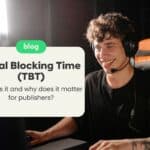Total Blocking Time (TBT): What is it and why does it matter for publishers?
The Total Blocking Time (TBT) is crucial for publishers, improving user experience, SEO, and accessibility. Grumft optimizes your site for maximum monetization.

Total Blocking Time (TBT) is a fundamental metric that publishers and developers need to understand and optimize to ensure superior performance of their websites. With growing competition in the digital environment, understanding and improving TBT is crucial to remain relevant and competitive.
What is Total Blocking Time?
Total Blocking Time (TBT) measures the responsiveness of a web page during its loading process. In simple terms, TBT quantifies the total time a page remains unavailable for user interaction, from the initial rendering of content (First Contentful Paint – FCP) until the page becomes fully interactive (Time to Interactive – TTI).
Importance of TBT for Publishers
Improving User Experience
A low Total Blocking Time ensures that users can quickly interact with the site, consuming content and performing actions without frustration. This leads to greater engagement, lower bounce rates, and better conversion rates. Publishers offering a fast and smooth user experience keep their audience satisfied and loyal.
Impact on SEO
Google considers TBT as one of the main Core Web Vitals, critical factors for ranking in search engine results pages. An optimized TBT improves your site’s position in search results, increasing organic traffic and, consequently, revenue. TBT is one of the metrics Google uses to evaluate user experience and directly influences your site’s performance in search rankings.
Ensuring Accessibility
A low TBT ensures that your site is accessible to all users, including those with slow connections or mobile devices. This demonstrates consideration for the diversity of your audience and prevents exclusions, expanding the reach of your content and services.
Strategies to Reduce TBT
Identifying Bottlenecks
Use tools like Lighthouse or PageSpeed Insights to analyze your site and identify elements causing blockages in the main thread. These tools provide detailed reports and specific suggestions to improve your site’s performance.
Minimizing Third-Party JavaScript
Avoid unnecessary scripts from libraries and ads that can delay page loading and increase Total Blocking Time. Prioritize essential scripts and defer less important ones until after the page is interactive.
Optimizing Images
Use compression and resizing techniques to reduce image sizes without compromising quality. Optimized images reduce loading times and, consequently, TBT. Tools like ImageOptim and TinyPNG can be helpful in this process.
Deferring Non-Essential Scripts
Use the defer or async API to load scripts that are not crucial for the initial rendering of the page. Deferring these scripts helps avoid blockages and improves page responsiveness.
Above-the-Fold Rendering
Use techniques like critical CSS and lazy loading to initially load only the elements above the fold. This allows users to quickly interact with the page while the rest of the content loads in the background. Tools like Critical and LazyLoad can help implement these techniques.
Additional Resources
To deepen your understanding of TBT and obtain official information, check out the following resources:
- Total Blocking Time (TBT) | Articles – web.dev
- Everything about Total Blocking Time (TBT) and PageSpeed – Ralf van Veen
- What Are Core Web Vitals and How to Measure Them to Improve Your Site – Hostinger
Conclusion
To maximize your site’s performance and provide an exceptional user experience, it is essential to optimize Total Blocking Time (TBT). If you are a publisher seeking new monetization opportunities and want to explore new ad formats without compromising user experience, contact Grumft. We specialize in website and app monetization, developing tags that do not interfere with user experience.
Rely on Grumft for the expertise you need. Our team is ready to help optimize your site and increase your revenue efficiently and sustainably.
Leia também:

Tu WordPress es un Rascacielos Digital. ¿Estás Ignorando las Grietas en sus Cimientos?

Your Slow Website is Costing You a Fortune. Here’s How to Prove It.

SEO 2025: Publishers’ Ultimate Guide to Dominate Search & Monetize Traffic
Autor(a):
Fernanda Calandro
Online desde 1997, sou uma profissional de marketing e conteúdo com formação robusta em marketing. Especializada em simplificar temas complexos através das minhas redações, eu facilito a conexão entre publishers e especialistas, promovendo um entendimento claro e acessível.
